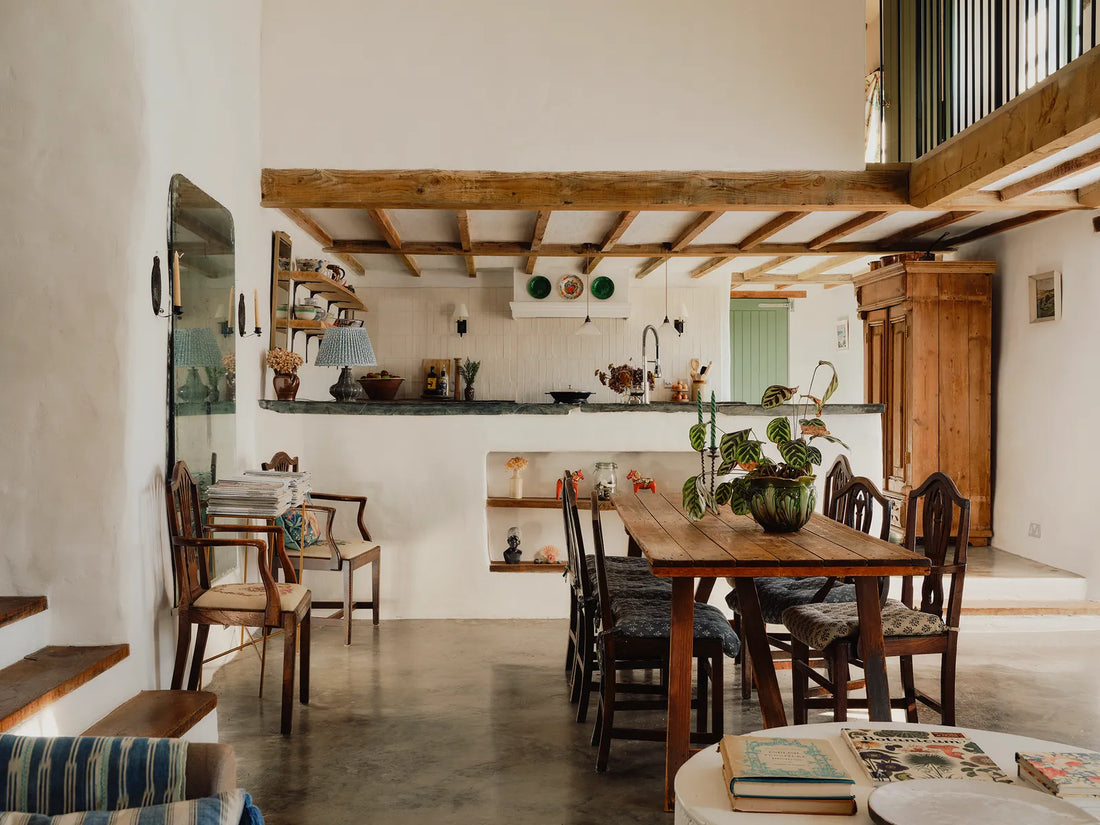
The Unexpected Magic of Vintage
Imagine a bare barn: soaring ceilings, exposed beams, stone or brick walls, and just enough weathered timber to hint at its history. It’s not your typical living space—it’s raw, full of scale and promise. You can’t just furnish it with flat-pack minimalism and call it a day. It needs soul. That’s where vintage and antiques come in—not as filler or ornament, but as storytellers that amplify the barn’s inherent character and bring its history to life.

Dean Hearne for Designer Hannah Yeomans
1. Texture & Time: Why antiques matter in a big, austere space
A barn’s architecture tends to be bold: large open volumes, heavy materials, a certain sculptural beauty. Being in such a space with only sleek new furniture can leave things feeling sterile. But slip in an antique table with worn edges, a velvet-covered sofa rescued from another era, or a vintage chest whose drawer still smells faintly of cedar, and suddenly the space acquires history.

Dean Hearne for Designer Hannah Yeomans
These items don’t just fill the space—they fill the gap between structure and human scale, between the monumental and the intimate. The patina, the marks of use, the slightly off-square joints—they all whisper “I’ve been around” in a good way. In a barn conversion, where the architecture says “big, open, rural, rugged,” antiques say “lived in, lived with, loved.”

Dean Hearne for Designer Hannah Yeomans
2. Layering the new + old: A smart strategy
You don’t have to buy everything second-hand, nor do you have to go full antique-museum. A wise mix is far smarter: keep the architectural bones (original beams, stone floors, vaulted ceiling) and juxtapose them with curated vintage pieces. A statement chandelier might be new, but resist the urge to match it perfectly to everything else. Let contrast be your friend.

Dean Hearne for Designer Hannah Yeomans
For instance: a modern kitchen island sits beneath exposed roof trusses; a 19th-century dining table takes centre-stage under that all-important vaulted space; a set of vintage chairs around it gives the scene an instant narrative beyond “brand new showroom.” These touches break the “just renovated” feel and give the place soul.

Dean Hearne for Designer Hannah Yeomans
3. The barn conversion as stage for character
Because barns tend to have an inherent drama—high windows, large volumes, rustic materials—they’re ideal for pieces that demand presence. A tall clock with a story, a set of reclaimed industrial lights, even an old trunk repurposed as a coffee table—it all works. Leather, wood, metal, faded fabrics: these bring scale, depth and tactility.

Dean Hearne for Designer Hannah Yeomans
Think of the barn not as a blank white box, but as a canvas that’s already doing heavy lifting. Your job with vintage/antiques is to anchor the space, to give it personality. Because you don’t want the barn to feel like an art gallery – you want it like someone stepped in and made it home.

Dean Hearne for Designer Hannah Yeomans
4. Picking the right vintage items (smart tips)
Here are some practical pointers:
Go for quality over quantity. One stellar vintage piece will carry more weight than a dozen innocuous “retro-style” ones.
Consider function + story. A table that’s been in use, a chest that has wear, a lamp with a provenance—they bring nuance.
Don’t match too much. If everything looks perfectly coordinated, you lose contrast. The beauty of vintage is imperfection.
Use colour and finish to anchor. A patinated brass lamp, a worn leather chair, or faded textiles add warmth amidst stone and timber.
Scale matters. In a barn’s large space, small furniture can feel lost. Use large vintage pieces or group smaller ones deliberately.
Mind the mix. Balance the rough keys (stone wall, timber beams) with soft finishes (fabric, upholstery) so the space doesn’t feel too rugged or too polished.

Dean Hearne for Designer Hannah Yeomans
5. Case in point: turning a barn into something remarkable
In one transformation I saw, the owners left much of the barn’s original features intact: thick stone walls, heavy slate countertops, old timber beams with flakes of plaster still clinging. They then introduced vintage furniture thoughtfully: chairs from the mid-century, textiles salvaged with interesting patterns, lighting that looked industrial but had aged gracefully. The effect: a space that felt open, architectural, but also deeply personal. The barn didn’t become a showroom—it became a home.

Dean Hearne for Designer Hannah Yeomans
6. The intangible payoff: soul, story, and sustainability
Beyond aesthetics, using vintage/antiques is smart on other levels:
Soul. New furniture lacks back-story. An antique chest suggests voyages, hands that have used it, decades of stories. That adds emotional depth to a space.
Sustainability. Re-using is inherently more sustainable than buying new. In large-scale spaces like barns, where you’re likely making major structural interventions anyway, adding vintage pieces is a conscious choice.
Uniqueness. You won’t find the same chair in five other homes; vintage gives individuality. In a barn with broad daylight and raw materials, uniqueness is gold.
7. Final word: Let the barn breathe, then fill selectively
If you’re converting a barn—or any large, characterful space—don’t rush to fill it all at once. Let it breathe. Let the architecture do some heavy lifting. Then bring in vintage and antiques not as afterthoughts, but as integral parts of the design narrative.
Think of each piece as a conversation partner with the space: the beam listens; the vintage chair speaks; the stone wall hums quietly. Together they make the barn not just livable, but compelling.
So if you’re staring at that open-plan barn shell—or even just a large, empty room—remember: it doesn’t need to look brand-new. It needs to look rich. It needs to look like someone cared, someone gathered pieces over time, someone wanted more than just “nice.” Vintage and antiques aren’t just accessories—they’re the catalysts that make a space feel alive.
-Juliette
